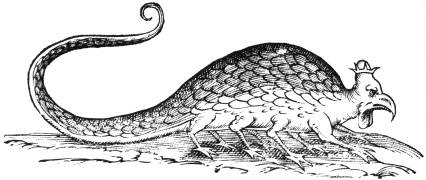Beware of the Basilisk
Posted by: Nick Redfern on July 25th, 2012

In a fascinating and huge post, Mike Dash details the long and winding story/history of the legendary Warsaw Basilisk, about which Mike says:
“Few creatures have struck more terror into more hearts for longer than the basilisk, a monster feared for centuries throughout Europe and North Africa. Like many ancient marvels, it was a bizarre hybrid: a crested snake that hatched from an egg laid by a rooster and incubated by a toad.”
About Nick Redfern
Punk music fan, Tennents Super and Carlsberg Special Brew beer fan, horror film fan, chocolate fan, like to wear black clothes, like to stay up late. Work as a writer.










The rooster laying the egg then being incubated by a toad sounds a bit far fetched. However i was thinking about it creatures similar to a basilisk existed… the dinosaurs velociraptors t-rex and many other dinosaurs had feathers, the tyrannosaurus supposedly had feathers and scales. It makes you think while reading this that its possible something similar or close to it could have existed.
There’s no need for a T-Rex; a chicken has feathers on its legs and scales on its feet.
If there was a real animal behind the basilisk stories, it has become so distorted as to be impossible to recognize.
arakan,
Although there was a recent discovery of an oriental feathered tyrranosaur, Yutyrranus huali, this monstrous reptilian measured approximately 30-feet in length and would therefore be much to conspicuous of a monster to reside virtually undetected in a region such as Europe. As nearly every sighting of relict tyrranosaurs that emerge from densely forested, sparsely inhabited regions of the world are either obvious hoaxes or one-time sightings that were also probably hoaxes of a type, it seems unlikely to me that there would be any such creature residing in a region that is not nearly as densely forested and with a considerably larger population density. Secondly, none of the description of the Basilisk is at all reminiscent of a feathered tyrranosaur with the exceptions of the presence of feathers and scales. Honestly, the monster is more similar to a glyptodont, but I know that this is not the identity of the Basilisk either. The basilisk is undoubtedly a montage of dozens of local animals and, although one could argue that some of the characteristics that are attributed to the Basilisk might have originated from local knowledge of an unrecognized taxon, this process is far too presumptious, not to mention it is impossible to objectively analyze this possibility as certain biases would undoubtedly, if inadvertently, taint the line of evidence. The analysis of the Basilisk is, in my opinion, a lost cause.